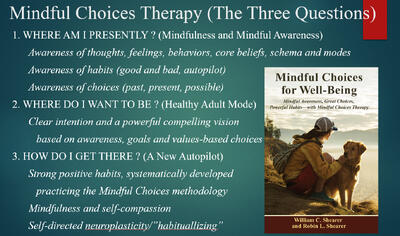.jpg&w=400&h=400)
We begin with a story. You’re about to meet Matt, and you’ll follow Matt throughout the book as his journey illustrates every step of his transformation from a life he didn’t much like to a life of well-being characterized by all the above qualities—and more. Of course, Matt doesn’t literally exist, at least not as a single person. Instead Matt, along with each of our other fictional examples, represents many of our actual clients, with their stories illustrating real journeys of growth, change, and transformation.
Matt’s Dis-ease
Matt was deep in thought as he began his morning shaving ritual. The guy in the mirror looked tired and worried. Taking a closer look and gazing intently, he saw a guy looking back who seemed to be carrying the weight of the world, a guy with bloodshot eyes from another night of not enough sleep, along with tense, drawn facial muscles framing a sad-looking face that didn’t smile much these days. Laughing was definitely out of the question. Matt couldn’t remember the last time he’d felt carefree and actually laughed out loud. Life seemed grim, and today would probably be no different than preceding days and weeks, stretching back, day by day, in a joyless, unrelenting stream of exhausting and highly stressful days. Life just wasn’t fun anymore. Would it ever be fun again?
In a few moments, he would be joining Beverly for breakfast, and once again she would voice her concerns. With growing frustration, she would remind him of his overdue physical, medical tests he continued to put off, his lack of exercise, and his poor nutrition—things he had heard again and again. Of course, it was all true. He would try to not get defensive, try not to see it as nagging. After all, she meant well. She truly loved him and only wanted to keep him around.
At some point, however, his irritation and defensiveness would take charge, and he would once again put her off with promises he knew deep in his heart he wouldn’t be keeping, at least not right away. There was too much that had to be done—deadlines to be met, bills to be paid, impatient customers to be dealt with, and a boss too overwhelmed by his own stresses to worry much about how Matt was doing.
Beverly had resolved to be patient. After all, Matt was working hard and had enough on his plate. Preaching to him about self-care didn’t seem to be working, but she was afraid and had to find some way of getting through to him. He seemed so tired each morning, and he would come home even more tired and irritable. Their relationship was suffering, and she hated that the most. Once seen as a close, fun-loving couple, for the past few months they seemed more like roommates, and roommates who no longer had “deep,” intimate conversations. She knew Matt still loved her, but his lifestyle was making him miserable and deeply affecting their life together. He was almost always anxious and grumpy and increasingly seemed depressed, and it was getting worse. Poor healthcare amplified the problems. Grabbing junk food on the run and never taking time for exercise had left Matt overweight, out of shape, and more easily fatigued, along with high blood pressure and possibly other serious health issues. Beverly was afraid. She had to find a solution, and soon!
On his way down to breakfast, Matt glanced at his watch. Late again! Grabbing his briefcase on the way to the kitchen, he stopped briefly to pour some coffee into a travel mug, snatch up two pieces of toast, and kiss Beverly goodbye. “Sorry Bev, it’s a late morning, and the traffic is always heavier on Monday. Gotta run. See you tonight.”
As Matt turned to race out the door, Beverly loudly exclaimed: “Hold it! I know you’re late, and you know I worry about you. I want sixty seconds of your time. Everything else can wait.”
Matt sighed deeply, glanced at his watch again, glanced at the determined and very serious look on Beverly’s face, and made a strategically wise decision. Putting down his briefcase, Matt took a deep breath and braced himself for the inevitable. “Okay, I’ve got sixty seconds, what’s up?”
“I know you think I’m a nag, but sometimes I think I can see the future—your future, my future, and our future—and it’s not good. Your lifestyle is killing you and us. I promise to stop nagging if you will do one simple thing. Joyce has been telling me that her husband had the same issues until he saw someone and worked on his stress management. I want you to do the same. I’ve got the phone number, and I want you to call – today! Do this for me, and I’ll back off. Deal?”
Thinking quickly, Matt overruled his first idea to put her off once again with empty promises. Seeing the look of unwavering determination in her eyes, he knew it probably wouldn’t work this time. Also, remembering the tired, haggard face in the mirror, he knew deep down she was right.
“Okay, I’ll make the call.” Beverly looked deep into his eyes: “Really? Today? You will call today?” There was nowhere to run or hide this time, and so Matt said, “Yes, I will call today.” Beverly hugged him and gave him a lingering, heartfelt kiss and a warm smile. “You don’t know how much this means to me. I’ll see you tonight.”
Epiphany and New Direction
Later that day, Matt found himself sitting down with Robin for his first “stress management” session. A brief assessment had revealed the obvious—Matt was a stress casualty, and it was getting worse. He felt overwhelmed. Stress and anxiety were taking a toll, and not surprisingly he was depressed as well as stressed and anxious. Now it was affecting his relationship and his health. He was finally convinced of the seriousness and urgency. It just couldn’t continue. He had to get things under control, and fast!
“Okay, tell me what I have to do. Isn’t there some simple checklist I can follow to get my stress under control? Whatever it takes, I will do it. I just have to start feeling better and managing my life better.”
Robin said, “I can see you feel a sense of urgency, and I see you’re ready for action. That’s good, but be aware, you’re now thirty-five years old and have had
years of practicing being uptight and stressed out. You will have to unlearn some well-practiced bad habits and have a totally different way of moving through your day from the time you get up in the morning until the time you go to sleep. And you will have to be highly motivated to follow through, placing exceptional self-care above all other tasks and obligations. It can’t be negotiable or subject to compromise. If something else can easily bump it out of first place on your list of priorities, I guarantee you it will, and nothing will change. You need to believe your number one mission on this planet is to take really excellent care of you, without exception or compromise. I’m talking about lifestyle change, the kind of change that comes about only through solid commitment, greatly increased awareness, choosing very different behaviors, having a clear sense of how you want your life to be different, and—most importantly—practice, practice, and more practice!”
Matt had been listening with great interest but also increasing anxiety. How long would this take? Where would he find the time? It sounded so involved, so complicated. Where would he start? What would he have to give up?
“Okay, I’m feeling a little overwhelmed. I thought this would be quick and easy, but I can see there is more to it than that. Where do I begin? Is there a checklist I can follow? What would a good day of stress management look like?”
Robin replied, “These are great questions. Let’s talk about some answers, so you can leave here today with a clear direction and even having made a solid beginning. First, though, as far as a checklist, the answer is a bit complicated. We can tell you based upon the assessments that there are lots of important choices you can make, choices that will make an immediate difference in your life as you commit to action and follow-through with focused practice.
“I suppose these choices constitute a kind of list, but not a checklist where you can simply perform a behavior, check it off your list, and consider that you are effectively managing your stress. It’s not a list of choices and behaviors that you can immediately activate and reap an immediate reward. It’s not a list of “doing,” but rather a way of “being” that you cultivate over time. It’s about lifestyle change and often a paradigm shift from where you are now to where you want to be in the future. The goal is important, of course, but it’s the process we need to focus on. It’s a process and a discipline, and it takes time and practice.”
Seeing Matt’s look of consternation, Robin added: “Don’t worry. With a little time and patience, you will make great changes. In fact, with the right plan you can transform your life. All you have to do is practice something called “mindful awareness” and learn a systematic process of self-observation, self-assessment, and mindful action—all things you can readily learn.
“The best news? What I’m proposing is not something where you have to wait a year to see results. You can start seeing results tomorrow, and it gets better and better as you work the process. We fully believe that down the road you can be a calm and peaceful person who’s enjoying the life he has created. Our program, Mindful Choices, covers virtually every aspect of a lifestyle transformation from a life of anxiety and stress to a life of well-being. There are literally thousands of choices that lead to improvements in your well-being and happiness.”
“However, it’s simply not practical to try to work on all choices at once. Some choices are more urgent and may require your immediate and undivided attention. Some choices you may have already mastered. Based on our in-depth Mindful Choices Self-Assessment, you can choose the area to work on that will give you the most immediate benefit. Once you have mastered that choice, you can move on to another choice. Altogether, mastery of our ten Mindful Choices takes time, but can result in a pretty terrific life.”
Matt had been listening with interest. “Okay, I get it. We are talking about lifestyle change, and lifestyle change takes commitment, focus, and a lot of practice. I’m ready to learn whatever it takes. First, though, how about my third question? What would it look like to have the perfect stress-management day? Also, how long will it take me to get started?”
Robin replied, “Let me tackle your second question first. You will get started before you leave this session, and I’m betting you’ll experience positive results very quickly. Now let’s talk about your first question. A hypothetical perfect stress-management day would include elements of all ten Mindful Choices and, although quite comprehensive, would also be highly individualized.
There can’t be a one-size-fits-all approach when it comes to stress management. Our role is coaching our clients to achieve, over time, their version of a calm, peaceful, and satisfying lifestyle. While you can begin incorporating elements of our ten choices in your stress-management day immediately, you will be finetuning these choices for quite some time, getting better and better results.”
Robin explained to Matt that even though he wanted immediate results, his journey needed to be one of commitment to the long haul, and ongoing. Lifestyle change means not only doing things differently, but also sustaining that effort—for life! She added that Matt, if patient and motivated, could ultimately achieve mastery of all ten ‘Mindful Choices,’ and therefore find himself transformed into a much calmer, more peaceful, and happier person whose choices had become solid positive habits.
As explained to Matt, the following are the ten Mindful Choices:
1. Breath Awareness and Retraining. This means developing a consciousness of breathing patterns so that you are instantly aware of becoming “uptight” and are able to use your awareness of your upper-chest breathing as a cue to immediately employ a relaxation response involving diaphragmatic breathing, or belly breathing. This step also involves literally retraining the way you breathe, developing a stress-reducing pattern of breathing that becomes more effective over time. Breath awareness is a basic relaxation and mindful awareness step, and foundational to all our Mindful Choices. It helps you activate “rest and digest,” rather than “fight or flight.”
2. Beginning and Ending Your Day Peacefully. Begin your day with calmness, rather than anxiety and stress. Consciously and intentionally set the stage for moving through your day in “cruise mode,” with ongoing awareness of your intention to have a great day. Ending your day peacefully and settling in for a night of peaceful and revitalizing sleep is perhaps even more important than beginning your day well.
3. Mindful Eating. Beginning with breakfast and incorporating healthy nutrition, mindful eating is about taking the time to slow down and focus on food in a pleasurable, non-anxious manner without distraction. Not only is this the secret to healthy and enjoyable eating, but it also provides stress breaks at regular intervals during your day to reconnect with yourself and regain your balance. Your relationship to food is a metaphor for your relationship with your life. If you eat on the run, eat rapidly, eat junk food, multitask while eating, or are too busy for meals, be aware that this is how you are treating your life.
4. Staying Present and Cultivating Mindfulness. This choice is about cultivating the all- important self-discipline of presentmoment awareness. You can greatly enhance your well-being by cultivating mindfulness skills and even learning mindfulness meditation. For example, one mindfulness skill, frequently checking in with yourself, with your mind and with your body, is a vital step in cultivating the mindful awareness vital to effective stress and anxiety management.
At least once an hour, if not more frequently, you can check in with yourself with what is known as a mind-body scan, taking stock of your anxiety and stress, your thoughts and feelings, and what’s going on in your body. You can use your awareness of your stress level as a cue to plug- in a learned relaxation response, calming and centering yourself, and readying yourself to move forward in a purposeful and intentional way, never losing sight of the importance of excellent self-care.
5. Engaging in Self-Reflection. Engaging in self-reflection and dealing with negative self-talk and distorted thinking with awareness, acceptance, and realistic self-talk or diffusion is a key to transforming a life filled with stress, anxiety, and depression to a life that can be fully satisfying.
6. Connecting with and Living Your Deepest Values. Knowing what’s really important is your compass. One of the most powerful ways we know of reducing stress, anxiety, and depression and becoming a calmer and more peaceful person is possessing a clear sense of your values and having an unwavering commitment to living those values.
7. Intentional Relating. Actively connecting with those who matter most to you and with others in a purposeful, constructive, and satisfying way while masterfully managing conflict eliminates or reduces perhaps the biggest source of stress in our lives. At the same time, positive relationships are a key component of well-being.
8. Physical Activity and Mindful Movement. Regular exercise that includes aerobics, strength training, and developing flexibility, along with gentle movement with peaceful thoughts and self-calming inner dialogue, are essential to effective anxiety and stress-management practice. Mindful movement is a way of connecting your body to your life in a most positive way.
9. Develop and Utilize Your Mindful Choices Toolbox. You need regular activities that enrich, restore, revitalize, and reenergize your life and renew your spirit. For example, some form of meditation/relaxation/mental imagery or visualization helps maintain equilibrium and promotes overall wellbeing. Consider yoga, mindfulness meditation, Tai Chi,
mindful journaling, and other practices for enriching your life. The list of possible tools is limitless. Whether meditation or gardening, the important thing is to have practices that enrich your life, revitalize you, and consistently contribute to highlevel well-being.
10. Self-Acceptance and Self-Compassion. This is perhaps the most important choice. Research indicates that people who are compassionate toward their failings and imperfections experience greater well-being than those who repeatedly judge themselves. Give yourself the same caring support you’d give to a good friend.
The Vision
Robin went on. “Matt, I’d like you to use your imagination for a moment. These ten choice areas encompass everything we teach about not only managing stress, anxiety, and depression, but also about achieving a high level of well-being. Together, they make up a system for transforming the life you have into the life you want. It takes commitment, time, and practice. Over time, you will find transformation to well-being taking place. Back to your question: What would it be like to be performing well in all choice areas?
“Imagine:
• Being able to use your breath to quickly calm and center yourself and make emotionally intelligent choices, moment by moment.
• Being able to begin and end your day in such a way that your day is deeply satisfying and relatively free of stress and anxiety.
• Being able to relax and enjoy meals, make positive food choices, and utilize mealtime as a way to connect positively with your body and with life.
• Being able to be aware and intentional throughout your day so you feel confident, peaceful, and fully alive, moment by moment.
• Choosing to defuse and detach from negative thoughts and beliefs, instead viewing the world in a more positive, realistic, and compassionate manner.
• Believing that your day is meaningfully connected with your deepest values, and your life is meaningful and purposeful and deeply satisfying.
• Being masterful in your relationships, building positive relationships, and seeing your relationships as perhaps the richest part of your life.
• Being at home within your own body, enjoying movement, and finding deep satisfaction in seeing yourself as a physical and active person.
• Having a variety of well-practiced tools, such as the regular practice of meditation or yoga, that serve as a foundation for a calm, peaceful lifestyle.
• Practicing self-compassion and self-acceptance, letting go of harsh and critical self- judgment, consistently choosing an attitude of kindness toward self, recognizing you are one with all of humanity, with all of us being imperfect.
“Of course, we’re talking about a vision of near-perfect well-being. These are goals to aim for, and we don’t expect anyone to tackle everything at one time. That would simply be overwhelming and very impractical. Instead, we ask people to select choice areas based upon their assessment, and then to work intensively on those areas until they have seen significant progress and demonstrated to their own satisfaction that those choice areas are now areas of strengths and positive habits. Then it’s time to move on to new choice areas. In time, you will have a comfortable working knowledge of each of the ten areas, with powerful and positive new habits and the ability to rapidly choose healthy, values-based alternatives instead of old habitual responses.”
Robin added, “There is a world of choices within each area. Although you can begin to incorporate elements of each choice within your stress-management plan right away, further exploration and learning will help you become truly masterful.
“Before you leave, let’s talk more about what you can do right now, and how you can approach your day tomorrow in such a way that you should notice positive changes very quickly. Let’s start by practicing diaphragmatic breathing.”
Homecoming and a Paradigm Shift
Matt was home a little earlier than usual, and Beverly thought she noticed something different. Somehow, he didn’t look as frazzled as he did other Monday evenings. She tried not to be too excited or optimistic as she asked, “How did it go in your therapy session?”
Matt replied, “Better than I’d expected. I learned that managing my stress was more complicated than I thought. It’s not simple, and I’m now seeing a bigger picture."
“I learned that fully managing my stress and anxiety involves a systematic process of cultivating mindful self-awareness through self-assessment and selfreflection. Ultimately, my goal is lifestyle change through mindful action and practice. Mostly, I learned it’s all about choices, and choices that are connected to my values. I need to get back to a focus on what’s really important—and being present in the moment. I learned it’s about paying attention to what’s happening in the here and now, being clear about my intentions, and choosing, moment by moment, day by day, to do what really matters most.
“I’ll explain more about this over dinner. I learned I can start immediately on stress reduction, but also work on longer-term transformation to greater health and well-being. It’s going to take consistent and focused effort to break free from the pull of some bad habits, but I know I can do it. In fact, I’ve already started. I learned how to breathe diaphragmatically, and I’ve been practicing taking three deep breaths as a kind of mini relaxation—virtually instant de-stressing. Also, I’ll be taking time every day to develop a heightened awareness of my breath, over time retraining my breathing patterns.
“I’m already believing it will help. I made a commitment to continue the breathing practice and to work systematically for as long as it takes on other areas that need attention, including our relationship. I’ve been too stressed out to be much good for either one of us, and I feel badly about that. I don’t want to lose ‘us,’ and I’ve got to stop inflicting my stress on you and being too tired and preoccupied to make our time together what it should be. I want to be fully present for you and able to connect with you in a positive way that’s good for both of us. I’ve missed that.”
“I’ve missed that too,” replied Beverly. “Welcome back!”
“Life is the sum total of all your choices.”
–Johann Wolfgang von Goeth







